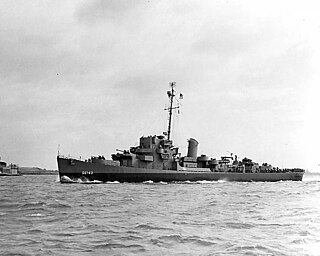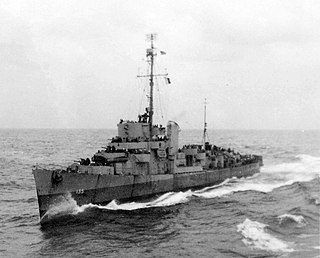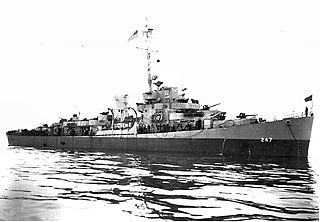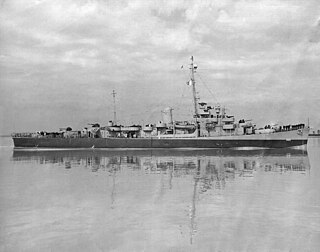
USS Underhill (DE-682) was a Buckley-class destroyer escort of the United States Navy during World War II. Built in 1943, she served in the Atlantic, the Mediterranean, and the Pacific until her sinking in a suicide attack by a Japanese Kaiten manned torpedo on 24 July 1945.

USS Sutton (DE-771) was a Cannon-class destroyer escort in service with the United States Navy from 1943 to 1948. In 1956, she was transferred to South Korea, where she served as Kang Won (F-72) until 1977. The ship was then cannibalized for spare parts in the Philippines.

USS Raby (DE/DEC-698) was a Buckley-class destroyer escort for the United States Navy. She was named for Rear Admiral James Joseph Raby (1874–1934).

USS England (DE-635), a Buckley-class destroyer escort of the United States Navy, was named in honor of Ensign John C. England (1920–1941), who was killed in action aboard the battleship Oklahoma during the Japanese attack on Pearl Harbor on 7 December 1941. Her sinking of six Japanese submarines in twelve days is a feat unparalleled in the history of antisubmarine warfare.

USS Mason (DE-529), an Evarts-class destroyer escort, was the second ship of the United States Navy to be named Mason, though DE-529 was the only one specifically named for Ensign Newton Henry Mason. USS Mason was one of two US Navy ships with largely African-American crews in World War II. The other was USS PC-1264, a submarine chaser. These two ships were manned by African Americans as the result of a letter sent to President Roosevelt by the NAACP in mid-December 1941. Entering service in 1944, the vessel was used for convoy duty in the Battle of the Atlantic for the remainder of the war. Following the war, Mason was sold for scrap and broken up in 1947.

USS Fiske (DE-143) was an Edsall-class destroyer escort built for the United States Navy during World War II. Named for Rear Admiral Bradley Allen Fiske, she was the first of two U.S. Naval vessels to bear the name. The vessel entered service in 1943 and served in the Atlantic Ocean during World War II as part of a hunter-killer anti-submarine group. On 2 August 1944, Fiske was sunk by a torpedo fired by the German submarine U-804. Thirty-three of the ship's crew were killed and a further 50 were injured.

USS Roche (DE-197) was a Cannon-class destroyer escort in service United States Navy from 1944 to 1945. She hit a mine in late September 1945. As it was uneconomical to repair her, she was scuttled in March 1946.

USS Huse (DE-145) was launched by Consolidated Steel Corp., Orange, Texas on 23 March 1943; sponsored by Mrs. L. M. Humrichouse, daughter of Admiral Harry McLaren Pinckney Huse who the ship was named after and commissioned on 30 August 1943.

USS Carter (DE-112) was a Cannon-class destroyer escort in service with the United States Navy from 1944 to 1946. In 1948, she was sold to Taiwan where she served as Taizhao. She was scrapped in 1974.

USS Gustafson (DE-182) was a Cannon-class destroyer escort in service with the United States Navy from 1943 to 1946. In 1950, she was transferred to the Royal Netherlands Navy where she served as Hr.Ms. Van Ewijck (F808) until 1967. She was scrapped in 1968.

USS Flaherty (DE-135) was an Edsall-class destroyer escort in service with the United States Navy from 1943 to 1946. She was sold for scrap in 1966.

USS Tomich (DE-242) was an Edsall-class destroyer escort in service with the United States Navy from 1943 to 1946. She was scrapped in 1974.

USS J. Richard Ward (DE-243) was an Edsall-class destroyer escort built for the U.S. Navy during World War II. She served in the Atlantic Ocean the Pacific Ocean and provided destroyer escort protection against submarine and air attack for Navy vessels and convoys. She was named in honor of James Richard Ward who was awarded the Medal of Honor posthumously for his heroic efforts under fire on the USS Oklahoma (BB-37). She was launched by Brown Shipbuilding Co., Houston, Texas, 6 January 1943; sponsored by Miss Marjorie Ward, sister of Seaman First Class Ward; and commissioned 5 July 1943.

USS Snowden (DE-246) was an Edsall-class destroyer escort built for the U.S. Navy during World War II. She served in the Atlantic Ocean the Pacific Ocean and provided destroyer escort protection against submarine and air attack for Navy vessels and convoys.

USS Stanton (DE-247) was an Edsall-class destroyer escort built for the U.S. Navy during World War II. She served in the Atlantic Ocean the Pacific Ocean and provided destroyer escort protection against submarine and air attack for Navy vessels and convoys.

USS Mosley was an Edsall-class destroyer escort built for the U.S. Navy during World War II. She served in the Atlantic Ocean the Pacific Ocean and provided destroyer escort protection against submarine and air attack for Navy vessels and convoys.

USS Lowe (DE-325) was an Edsall-class destroyer escort in service with the United States Navy from 1943 to 1946 and from 1955 to 1968. Between 1951 and 1954 she was loaned to the U.S. Coast Guard as USCGC Lowe (WDE-425). She was scrapped in 1969.

USS Janssen (DE-396) was an Edsall-class destroyer escort in service with the United States Navy from 1943 to 1946. She was sold for scrapping in 1973.

USS Neunzer (DE-150) was an Edsall-class destroyer escort in service with the United States Navy from 1943 to 1947. After spending several decades in reserve, she was sold for scrap in 1973.

USS Jack W. Wilke (DE-800) was a Buckley-class destroyer escort of the United States Navy.




















